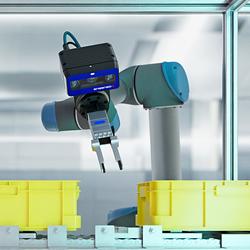MathWorks Introduces Robotics System Toolbox for Complete Integration with Robot Operating System (ROS)
Allows engineers to use MATLAB and Simulink to design, test, and deploy robotics algorithms
NATICK, Mass.--MathWorks today announced the introduction of Robotics System Toolbox, a new product as part of Release 2015a. With ready-to-use algorithms and hardware connectivity for developing autonomous mobile robotics applications, Robotics System Toolbox provides an interface and complete integration between MATLAB and Simulink, and the Robot Operating System (ROS). Now, robotics researchers and engineers can work in a single, integrated design environment to design, test, and deploy robotics algorithms on ROS-enabled robots and robot simulators such as Gazebo and V-REP. This creates more time to focus on design explorations and iterations by reducing the manual rework of conversion from MATLAB to ROS.
Algorithms offered within Robotics System Toolbox include map representation, path planning, and path following for differential drive robots. Engineers can now design and prototype motor control, computer vision, and state machine applications in MATLAB or Simulink, and they can integrate them with core algorithms in Robotics System Toolbox. Engineers can also generate a ROS node from a Simulink model and deploy it to a ROS network through the automatic C++ code generation support.
Robotics students and educators are already using MATLAB and Simulink to develop algorithms, visualize robot behavior, and analyze log data. Now, they can program a robot or a simulator inside MATLAB and Simulink while continuing to work with MathWorks hardware support packages for robotics hardware.
"Robotics System Toolbox brings the algorithm development and system design capabilities of MATLAB and Simulink to the exciting world of Robotics," said Sameer Prabhu, industry marketing director, MathWorks. "Researchers, engineers, and students can now develop a variety of mobile robot applications for use in automotive, aerospace, defense, medical, and industrial automation systems in a fully integrated environment featuring MATLAB and Simulink, and ROS-enabled robots and simulators."
Availability and Pricing:
Robotics System Toolbox is available immediately worldwide. For pricing and more information, visit mathworks.com/products/robotics.
About MathWorks
MathWorks is the leading developer of mathematical computing software. MATLAB, the language of technical computing, is a programming environment for algorithm development, data analysis, visualization, and numeric computation. Simulink is a graphical environment for simulation and Model-Based Design of multidomain dynamic and embedded systems. Engineers and scientists worldwide rely on these product families to accelerate the pace of discovery, innovation, and development in automotive, aerospace, electronics, financial services, biotech-pharmaceutical, and other industries. MathWorks products are also fundamental teaching and research tools in the worlds universities and learning institutions. Founded in 1984, MathWorks employs more than 3000 people in 15 countries, with headquarters in Natick, Massachusetts, USA. For additional information, visit mathworks.com.
Featured Product

